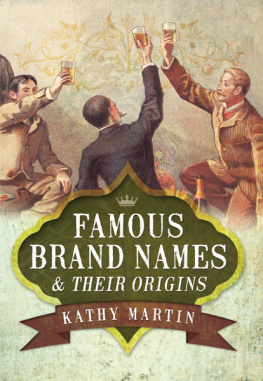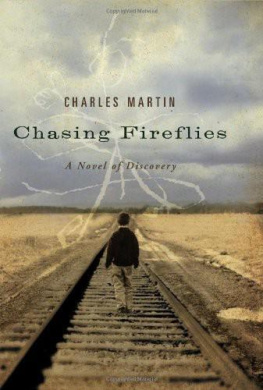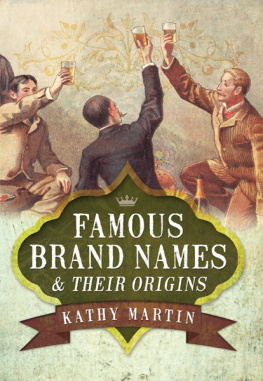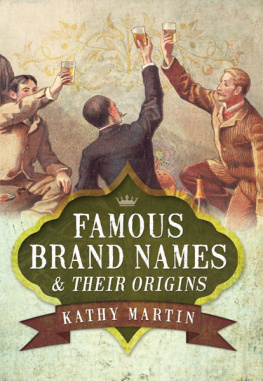
For Margaret and Gavin, two unique brands originating in the Thirties.
First published in Great Britain in 2016 by
Pen & Sword History
an imprint of
Pen & Sword Books Ltd
47 Church Street
Barnsley
South Yorkshire
S70 2AS
Copyright Kathy Martin 2016
ISBN: 978 1 78159 015 7
PDF ISBN: 978 1 52670 186 2
EPUB ISBN: 978 1 52670 185 5
PRC ISBN: 978 1 52670 184 8
The right of Kathy Martin to be identified as the Author of this Work has been asserted by her in accordance with the Copyright, Designs and Patents Act 1988.
A CIP catalogue record for this book is available from the British Library
All rights reserved. No part of this book may be reproduced or transmitted in any form or by any means, electronic or mechanical including photocopying, recording or by any information storage and retrieval system, without permission from the Publisher in writing.
Typeset in Ehrhardt by
Mac Style Ltd, Bridlington, East Yorkshire
Printed and bound in the UK by CPI Group (UK) Ltd,
Croydon, CRO 4YY
Pen & Sword Books Ltd incorporates the imprints of Pen & Sword Archaeology, Atlas, Aviation, Battleground, Discovery, Family History, History, Maritime, Military, Naval, Politics, Railways, Select, Transport, True Crime, and Fiction, Frontline Books, Leo Cooper, Praetorian Press, Seaforth Publishing and Wharncliffe.
For a complete list of Pen & Sword titles please contact
PEN & SWORD BOOKS LIMITED
47 Church Street, Barnsley, South Yorkshire, S70 2AS, England
E-mail:
Website: www.pen-and-sword.co.uk
Contents
Introduction
I f the world sometimes seems to be changing with terrifying rapidity, surely there is a small measure of reassurance to be found in the knowledge that many of our most popular consumer brands have been with us for generations. In the supermarkets, in our homes, on the high street and in our leisure time we repeatedly come into contact with products bearing names that our forebears would recognise.
Imagine, if you will, a genteel lady from the late Victorian era finding herself transported by a time machine into the present. Bewildered by twenty-first century technology, astonished by our medical advances and very likely appalled by modern dress and behaviour, she may well require something to steady her nerves: a calming cup of Twinings tea, perhaps, or, should a stronger beverage be required, a restorative glass of Guinness. Since both brands were well-established in her day, their familiar presence might leave her sufficiently emboldened to catch up on world events. She could do this by glancing at a copy of The Times, already well-established in her own day or, for a lighter read, by perusing the latest issue of The Lady which was first published in 1885. Of course all the aforementioned products looked rather different in her era but the point is that our intrepid time traveller would recognise and be comforted by their brand names.
Conversely, the purpose of this book is to serve as a guide for those wishing to time travel in the opposite direction. Journeying into the past to look at some of the most popular consumer brands found in everyday life tracing their origins, their development and their place in society today we will discover that there is much more to celebrate than the simple fact of their continuing existence. Ingenious inventors, daring entrepreneurs, determined Nonconformists, spirited widows, gutsy refugees, forward-thinking philanthropists and a handful of decidedly racy characters; who knew the originators of our most famous brand names were so colourful?
What and where
For ease of navigation, the book is divided into two parts, Food & Drink and House & Home. In the first you will find chapters covering edible brands ranging from confectionery to beverages. And, since not everything we eat is branded, at the close of Food & Drink there is an extra chapter dealing with the origins of unbranded generic eponyms such as Beef Wellington and Waldorf Salad. In House & Home, meanwhile, you will find everything from toys and travel guides to Sellotape and supermarkets.
To set the scene, each chapter opens with an explanatory paragraph or two before moving on to the featured brands which are listed in alphabetical order. Additionally, for some brands, Did you know ? boxes have been included, containing snippets of information that may not be entirely relevant to the brands story but are interesting nonetheless.
Getting down to the nitty gritty
With an almost infinite number of products to choose from, it was decided that to qualify for inclusion, brands had to meet the following conditions:
they must be at least fifty years old
remain in production today
possess widespread consumer appeal
Furthermore, the decision was made to focus on brands with engaging or otherwise noteworthy histories. Fortunately, even after these criteria had been applied there were still rich pickings to choose from because, by and large, the pioneering entrepreneurs of yesteryear were a lively crowd.
Of course, some brand names remain well-loved long after they have fallen into extinction. In order to include at least a few of these fallen, each category features a gone but not forgotten section. Similarly, brief honourable mentions have been given to a number of popular brands that have not yet reached their half-century and therefore fail to qualify for full inclusion.
Now, gentle reader, with the thought processes behind this book duly explained, all that remains is for you to settle back and prepare for an enjoyable meander down memory lane. The wearing of rose-tinted spectacles is optional.
Part I
Food & Drink

Chapter 1
The Pantry
P rior to the invention of the refrigerator, perishable food items such as butter, cheese, milk, eggs and meat were stored inside small rooms or large cupboards known as pantries and larders. Located either inside the kitchen or adjacent to it, these rooms were usually north-facing to keep them out of the sun. Some had mesh-covered windows which allowed fresh air to circulate whilst keeping flies away. To help them stay cool, the perishable foodstuffs were placed on stone slabs although if space allowed joints of meat would be hung from ceiling hooks.
Did you know ?
The word pantry is derived from pain, the French word for bread which itself comes from panis, the Latin word for bread.
Originally, when most people still created their meals from scratch using a few basic ingredients, the walls of the pantry or larder would be lined with shelves containing longer-lasting foodstuffs such as flour, sugar, salt and spices. It wasnt until the nineteenth century that the first convenience foods became available but thereafter the pantry shelves of a prosperous household groaned with a cornucopia of tempting products, all designed to make life easier for the busy cook.
Canned food had been available in Britain since 1813 but for much of the century it was mainly regarded as a useful tool for the armed forces and intrepid types such as polar explorers. It wasnt until the early years of the twentieth century that it really caught on with the public, perhaps because until then nobody had thought to invent a decent can opener. After that, however, canned food had arrived in a big way and its place on pantry shelves across the nation was assured.
Next page
















